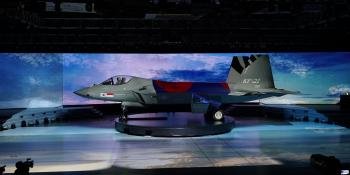NEARLY FOUR YEARS after South Korea’s KF-X project officially kicked off, a mock-up of the new fighter was unveiled at Seoul ADEX 2019, which was held from October 15-20. Designed by Korea Aerospace Industries (KAI), the new aircraft will eventually enter service with the Republic of Korea Air Force (ROKAF) in the second half of the next decade.
The twin-engine design somewhat resembles the F-35, though it is slightly longer at 55ft (16.9m) but has an almost identical wingspan of 37ft (11.2m). KAI describes it as an ‘affordable mid-class fighter’ and claims maintenance costs will be half those of the F-35. It will be available in single and tandemseat configurations, with the mockup depicting the former. The aircraft will be powered by a pair of General Electric F414 turbofans and it will have a maximum take-offweight of 56,438lb (25,600kg), with an allup payload capacity of 16,975lb (7,700kg) on 10 hardpoints. As an indicative loadout, the mock-up carried a pair of external fuel tanks, two laser-guided bombs, two IRIS-T missiles and, under the belly, four Meteor missiles. Fitted on the right-hand ‘shoulder’ was a Sniper targeting pod, and an M61 Vulcan 20mm cannon was situated on the port side.
South Korean firm LIG Nex1 is developing a long-range airlaunched cruise missile specifically for use on the KF-X. On display at Seoul, the air-to-ground missile looks similar to the Taurus KEPD 350 already used by the ROKAF, and it presumably has comparable performance parameters. KAI noted that its blue-ribbon fighter is ‘designed for future growth’. Thus, follow-on blocks of the KF-X should feature internal weapons carriage.
The KF-X is enjoying technical input from foreign entities, including Lockheed Martin as a technical partner. However, because the US did not grant export approval for some sensitive systems, South Korea has been forced to rely on local talent or to look elsewhere. For example, Israel Aerospace Industries (IAI)/ Elta is supporting development of the fighter’s active electronically scanned array (AESA) radar. This AESA radar has a reported range of 68.4 miles (110km) and is being developed by Hanwha Systems. The first working radar is to be unveiled in the second half of 2020, though testing on the KF-X will not occur until 2023.
Hanwha is also developing the electro-optical targeting pod, infrared search and track (IRST) system and radio frequency jammer. LIG Nex1 is contributing the electronic countermeasures, head-up display (HUD), datalink and radios. As well as the full-size mock-up that was on show outdoors, KAI exhibited a separate replica of the fighter’s cockpit. It boasts a 20 x 8in (50 x 20cm) touchscreen display that integrates with the pilot’s helmet and HUD.
Indonesia is contributing financially to this $7.4-billion project, with up to 48 KF-X fighters earmarked for its use. Jakarta is supposed to be paying 20 per cent of the project cost, although it is believed to be in arrears and the two sides are attempting to renegotiate terms.
According to officials, the project is on schedule and a critical design review was successfully passed in September this year. The current timeline demands a KF-X prototype to be ready in the first half of 2021, with the maiden fiight supposed to happen shortly afterwards. If the program runs smoothly, the KF-X is scheduled to be ready for the ROKAF by 2026.

![Meteor KF-X [KIA] Thumbnail](https://fullfatthings-keyaero.b-cdn.net/sites/keyaero/files/styles/listing_card/public/2019-11/capture.png?h=b6998be9&itok=Ffx-oR_k)
![KAI KF-X [KAI] Thumbnail](https://fullfatthings-keyaero.b-cdn.net/sites/keyaero/files/styles/listing_card/public/2020-02/kai_kf-x_kai_1.jpg?h=2244d1e1&itok=Xl-uNlxl)


